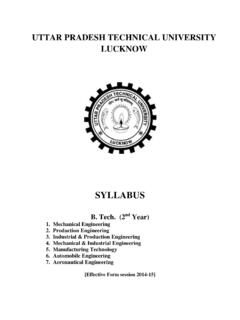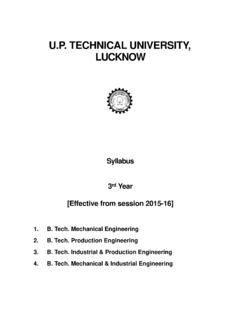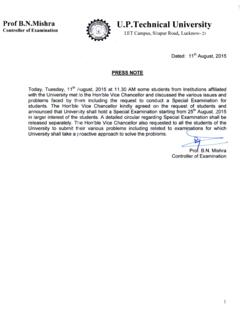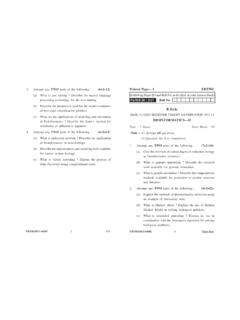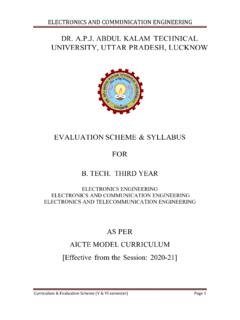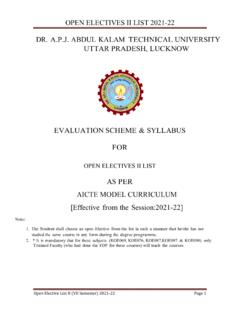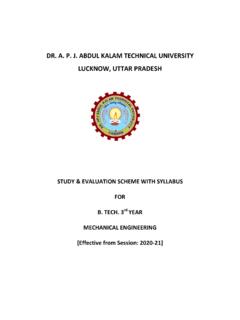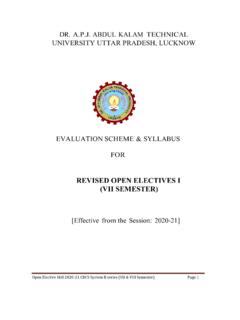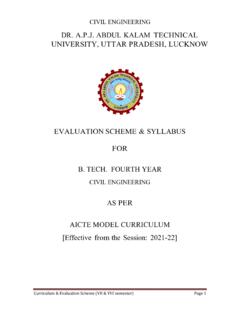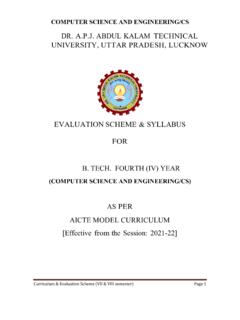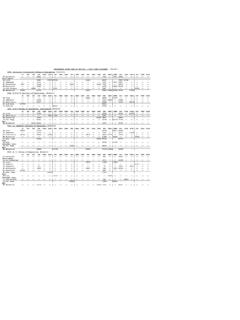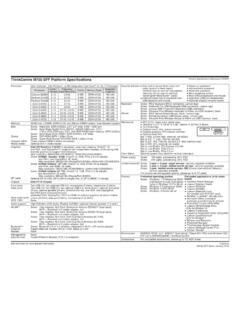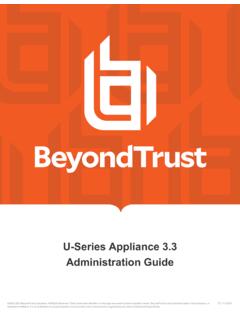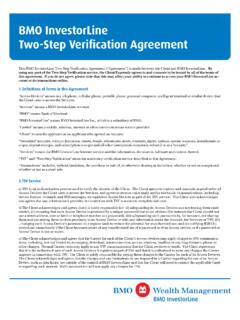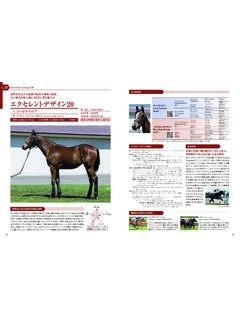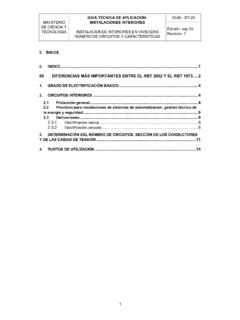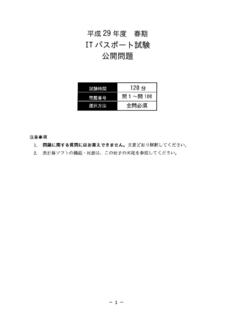Transcription of (All Branch except Agriculture (AG) and Biotechnology (BT)
1 Revised Structure B. Tech 1st Year (Common). DR. ABDUL KALAM TECHNICAL. UNIVERSITY, LUCKNOW. REVISED EVALUATION SCHEME. &. SYLLABUS. FOR. B. TECH. I YEAR. (All Branch except Agriculture (AG). and Biotechnology (BT). ON. AICTE MODEL CURRICULUM). [Effective from the Session: 2020-21]. Revised Structure B. Tech 1st Year (Common). UG Stream Vs Allied Branch Classification 2020-21 Code Stream Branch Name Civil Engineering CE. Civil Engineering Environmental Engineering EV. Chemical Engineering CH. Chemical Engineering Food Technology FT. Computer Engineering (2019-20) CS. Computer Science CS. Computer Science and Engineering (CS) CSE. Computer Engineering And Information Technology CSA. Computer Science and Information Technology CSIT. Computer Science IT. Information Technology Computer Science and Engineering (Artificial Intelligence) 2020-21 CSAI. Computer Science and Engineering(Artificial Intelligence & Machine CSME. Learning) 2020-21.
2 Computer Science and Engineering (Data Science) 2020-21 CSDS. Computer Science and Engineering (Internet Of Things) 2020-21 CSIOT. Electrical Engineering EE. Electrical Engineering Electrical & Electronics Engineering EN. Applied Electronics & Instrumentation AI. Bio Medical Engineering BM. Instrumentation and Control Engineering, Instrumentation Engineering IC. Electronics Engineering EL. Electronics Engineering Electronics and Communication Engineering EC. Electronics And Computer Engineering Electronics and Instrumentation Engineering EI. Electronics & Telecommunication Engineering ET. Aeronautical Engineering AE. Automobile Engineering AU. Industrial Production Engineering IP. Manufacturing Technology MT. Mechanical Engineering Mechanical and Industrial Engineering MI. Mechanical Engineering ME. Plastic Engineering PL. Production Engineering PE. Carpet & Textile Chemistry CT. Textile Chemistry TC. Textile Engineering Textile Technology TT.
3 Handloom & Textile Technology 2020-21 HTT. Revised Structure B. Tech 1st Year B. Tech 1st Year (All branches except Bio Technology and Agriculture Engg.). Revised Structure in accordance with AICTE Model Curriculum Effective Academic Session 2020-21. SEMESTER I. 3 WEEKS COMPULSORY INDUCTION PROGRAM. AICTE Guidelines in Model Curriculum: After successful completion of 160 credits, a student shall be eligible to get Under Graduate degree in Engineering. A student will be eligible to get Under Graduate degree with Honours only, if he/she completes additional university recommended courses only (Equivalent to 20 credits; NPTEL Courses of 4 Weeks, 8 Weeks and 12 Weeks shall be of 2, 3 and 4. Credits respectively) through MOOCs. For registration to MOOCs Courses, the students shall follow NPTEL Site as per the NPTEL policy and norms. The students can register for these courses through NPTEL directly as per the course offering in Odd/Even Semesters at NPTEL.
4 These NPTEL courses (recommended by the University) may be cleared during the B. Tech degree program (not necessary one course in each semester). After successful completion of these MooCs courses the students, shall, provide their successful completion NPTEL status/certificates to the University (COE). through their college of study only. The student shall be awarded Hons. Degree (on successful completion of MOOCS based 20 credit) only if he/she secures or above CGPA and passed each subject of that Degree Programme in single attempt without any grace marks. Curriculum & Evaluation Scheme (I & II semester) Page 3. Revised Structure B. Tech 1st Year I Semester (All branches except Bio Technology and Agriculture Engg.). S. Course Course Title Periods Evaluation Scheme End Total Credits No. Code Semester L T P CT TA Total PS TE PE. 1 KAS101T/ Engineering Physics/ 3 1 0 30 20 50 100 150 4. KAS102T Engineering Chemistry 2 Engineering Mathematics-I 3 1 0 30 20 50 100 150 4.
5 KAS103T. 3 Basic Electrical Engineering/. KEE101T/ 3 0 0 30 20 50 100 150 3. Emerging Domain in Electronics KEC101T Engineering 4 KCS101T/ Programming for Problem Solving / 3 0 0 30 20 50 100 150 3. KME101T Fundamentals of Mechanical Engineering & Mechatronics 5 Engineering Physics Lab/ 0 0 2 25 25 50 1. KAS151P/. Engineering Chemistry Lab KAS152P. 6 KEE151P/ Basic Electrical Engineering Lab/ 0 0 2 25 25 50 1. KEC151P Electronics Engineering Lab 7 KCS151P/ Programming for Problem Solving / 0 1 2 25 25 50 1. KAS154P English Language Lab 8 KCE151P/ Engineering Graphics & Design Lab/. 0 1 2 50 50 100 1. KWS151P Mechanical Workshop Lab 9 AI For Engineering/ 25. KMC101/ 2 0 0 15 10 25 50 2. Emerging Technology for KMC102 Engineering 10 KNC101 Soft Skill I NC. 2 0 0 15 10 25 25. 11 MOOCs (For Hons. Degree)*. Total 900 20. Curriculum & Evaluation Scheme (I & II semester) Page 4. Revised Structure B. Tech 1st Year II Semester (All branches except Bio Technology and Agriculture Engg.)
6 S. Course Course Title Periods Evaluation Scheme End Total Credits No. Code Semester L T P CT TA Total PS TE PE. 1 KAS201T/ Engineering Physics/. 3 1 0 30 20 50 100 150 4. KAS202T Engineering Chemistry 2 KAS203T Engineering Mathematics-II 3 1 0 30 20 50 100 150 4. 3 Basic Electrical Engineering/. KEE201T/ 3 0 0 30 20 50 100 150 3. Emerging Domain in KEC201T. Electronics Engineering 4 KCS201T/ Programming for Problem 3 0 0 30 20 50 100 150 3. KME201T Solving / Fundamentals of Mechanical Engineering &. Mechatronics 5 Engineering Physics Lab/ 0 0 2 25 25 50 1. KAS251P/. Engineering Chemistry Lab KAS252P. 6 KEE251P/ Basic Electrical Engineering Lab/ 0 0 2 25 25 50 1. KEC251P Electronics Engineering Lab 7 KCS251P/ Programming for Problem 0 1 2 25 25 50 1. KAS254P Solving / English Language Lab 8 KCE251P/ Engineering Graphics & Design 0 1 2 50 50 100 1. KWS251P Lab/ Mechanical Workshop Lab 9 AI For Engineering/ 25. KMC201/ 2 0 0 15 10 25 50 2.
7 Emerging Technology for KMC202 Engineering 10 KNC201 Soft Skill II NC. 2 0 0 15 10 25 25. MOOCs (For Hons. Degree)*. Total 900 20. Mini Project or Internship (3-4 weeks) shall be conducted during summer break after II. semester and will be assessed during III semester Curriculum & Evaluation Scheme (I & II semester) Page 5. Revised Structure B. Tech 1st Year 1st Year I Semester Syllabus Curriculum & Evaluation Scheme (I & II semester) Page 6. Revised Structure B. Tech 1st Year KAS-101T ENGINEERING PHYSICS 3L:1T:0P 4 Credits KAS-201T. Unit Topics Lectures I Relativistic Mechanics: Frame of reference, Inertial & non-inertial frames, 8. Galilean transformations, Michelson- Morley experiment, Postulates of special theory of relativity, Lorentz transformations, Length contraction, Time dilation, Velocity addition theorem, Variation of mass with velocity, Einstein s mass energy relation, Relativistic relation between energy and momentum, Massless particle.
8 II Electromagnetic Field Theory: Continuity equation for current density, 8. Displacement current, Modifying equation for the curl of magnetic field to satisfy continuity equation, Maxwell s equations in vacuum and in non conducting medium, Energy in an electromagnetic field, Poynting vector and Poynting theorem, Plane electromagnetic waves in vacuum and their transverse nature. Relation between electric and magnetic fields of an electromagnetic wave, Energy and momentum carried by electromagnetic waves, Resultant pressure, Skin depth. III Quantum Mechanics: Black body radiation, Stefan s law, Wien s law, 8. Rayleigh-Jeans law and Planck s law, Wave particle duality, Matter waves, Time-dependent and time-independent Schrodinger wave equation, Born interpretation of wave function, Solution to stationary state Schrodinger wave equation for one-Dimensional particle in a box, Compton effect. IV Wave Optics: Coherent sources, Interference in uniform and wedge 8.
9 Shaped thin films, Necessity of extended sources, Newton's Rings and its applications. Fraunhoffer diffraction at single slit and at double slit, absent spectra, Diffraction grating, Spectra with grating, Dispersive power, Resolving power of grating, Rayleigh s criterion of resolution, Resolving power of grating. V Fibre Optics & Laser: Optics: Introduction to fibre optics, 8. Acceptance angle, Numerical aperture, Normalized frequency, Classification of fibre, Attenuation and Dispersion in optical fibres. Laser: Absorption of radiation, Spontaneous and stimulated emission of radiation, Einstein s coefficients, Population inversion, Various levels of Laser, Ruby Laser, He-Ne Laser, Laser applications. Reference Books: 1. Concepts of Modern Physics Aurthur Beiser (McGraw Hill). 2. Introduction to Special Theory of Relativity- Robert Resnick (Wiley). 3. Optics Brijlal & Subramanian (S. Chand ). 4. Engineering Physics: Theory and Practical- Katiyar and Pandey (Wiley India).
10 5. Applied Physics for Engineers- Neeraj Mehta (PHI Learning, New). 6. Engineering Physics-Malik HK and Singh AK (McGrawHill). Course Outcomes: At the end of this course students will demonstrate the ability to: 1. To solve the classical and wave mechanics problems 2. To develop the understanding of laws of thermodynamics and their application in various processes 3. To formulate and solve the engineering problems on Electromagnetism & Electromagnetic Field Theory 4. To aware of limits of classical physics & to apply the ideas in solving the problems in their parent streams Curriculum & Evaluation Scheme (I & II semester) Page 7. Revised Structure B. Tech 1st Year KAS-102T ENGINEERRING CHEMISTRY 3L:1T:0P 4 Credits KAS-202T. Unit Topics Lectures I Atomic and Molecular Structure: Molecular orbital's of diatomic 8. molecules. Band theory of solids. Liquid crystal and its applications. Point defects in solids. Structure and applications of Graphite and Fullerenes.
